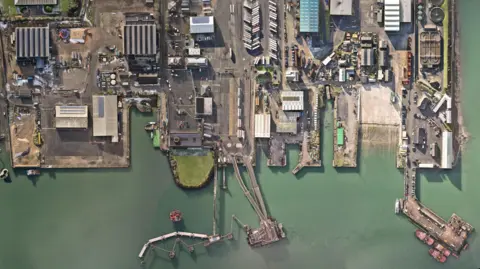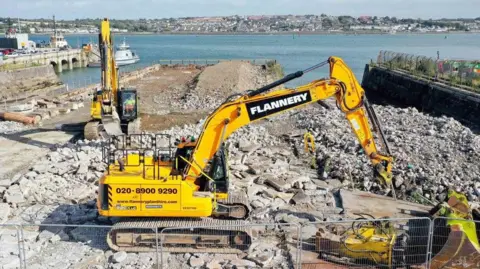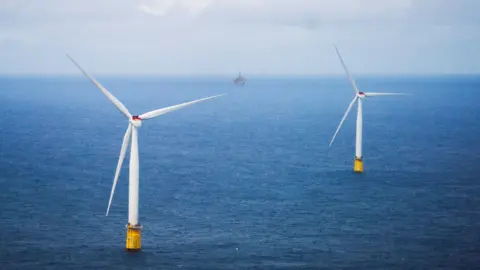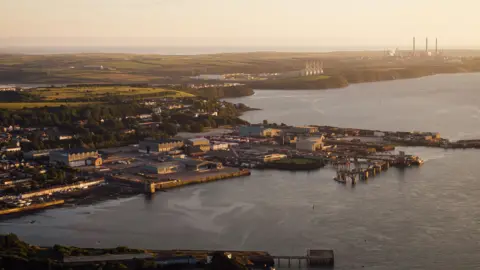£60m port revamp aims to create 1,800 jobs
 Milford Haven Port Authority
Milford Haven Port AuthorityA dockyard has been transformed into a "world-class centre" for wind, wave and tidal power projects following a £60m upgrade.
The revamped Pembroke Port will be officially opened later on Wednesday, ahead of what has been described as a "pivotal year" for marine energy in Wales.
It is hoped the changes - including a new "supersized slipway" - will attract renewable energy firms and create up to 1,800 new jobs.
But one industry body said far more government funding was needed to prepare Wales' ports to take full advantage of energy generation opportunities at sea.
The port at Pembroke Dock on the Milford Haven waterway in Pembrokeshire has an important place in British naval history.
The town itself was founded as a Royal Navy dockyard in 1814, and five Royal Yachts were among the many ships built there.
Later it became the world's largest military flying boat station during World War Two.
Now the site "stands on the threshold of a new epoch", said Tom Sawyer, chief executive of Milford Haven Port Authority.

The Pembroke Dock Marine programme aims to help turn the site into a "renewables port", he said.
Backed by UK and Welsh government funding, as well as private investment, it is part of the wider Swansea Bay City Deal.
Mr Sawyer said the development was "the culmination of years of hard work to create a multi-purpose" port in Pembroke Dock.
As well as an enlarged slipway and areas where companies can build and store devices and components, developers have also created new workboat pontoons, office and workshop facilities.
"The size of the slipways, the access from quayside into deep water is a fundamental requirement for many of the renewable technologies that are going out to sea," Mr Sawyer said.
The work adds to an existing Marine Energy Test Area (META) locally and the Pembrokeshire Demonstration Zone (PDZ), allowing firms to experiment with new technologies at sea.
 Milford Haven Port Authority
Milford Haven Port AuthorityThe proposals had faced opposition from several local and national heritage organisations, which criticised a potentially "catastrophic" impact on the port's historic buildings and infrastructure.
But Pembrokeshire council and ultimately the Welsh government decided the economic benefits from advancing the marine energy sector "far outweigh" those concerns.
 Reuters
ReutersClaire Lawrence, 32, joined the port as an apprentice 12 years ago but has risen through the ranks to become a project manager on the Pembroke Dock Marine programme.
Ahead of the official opening she said she was feeling "pretty proud".
"To be able to work on such a big project in your own county is really important and to see the magnitude of it is really impressive," she said.
"The ability for it to provide careers for local people especially for youngsters - knowing they don't have to move away from the area - that they can get good, well paid jobs locally - its something I'm really proud of."

A recent report on the state of the sector by Marine Energy Wales described the next 12 months as "pivotal".
The Crown Estate is set to start awarding seabed leases for firms looking to develop floating offshore windfarms in the Celtic Sea, the area between south Wales, Ireland and Cornwall.
The race is on to ensure Wales can capitalise on what is a major economic opportunity.
 Milford Haven Port Authority
Milford Haven Port AuthorityJessica Hooper, director of RenewableUK Cymru, said the Pembroke Dock Marine project was "an incredibly exciting opportunity for Pembrokeshire in particular".
"It should really help in cementing this region as somewhere to take forward and realise the opportunities" marine energy provided, she added.
But when it comes to floating offshore wind in particular, far more investment was needed to upgrade port infrastructure across south Wales, Ms Hooper said.
From the wind turbines' giant components to their foundations, they are "going to be of an order of magnitude that we've not yet seen", she said.
"This £60m is a very good stepping stone... but we're probably talking in the realm of a billion pounds needed to be brought forward".
